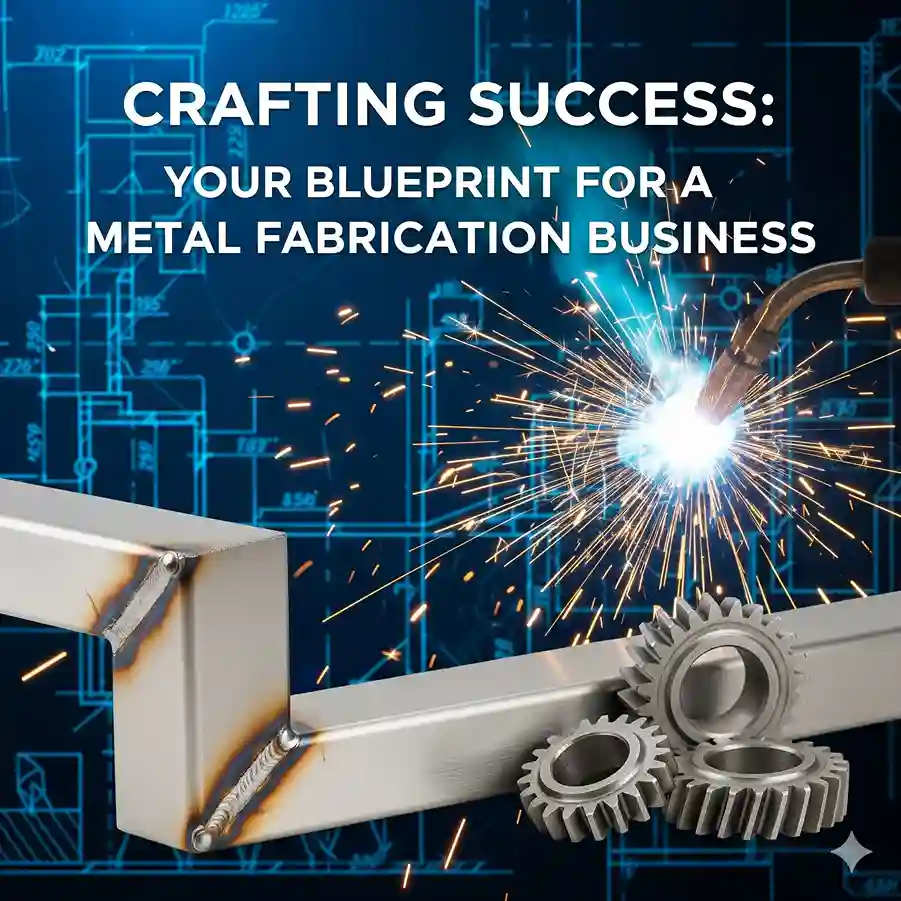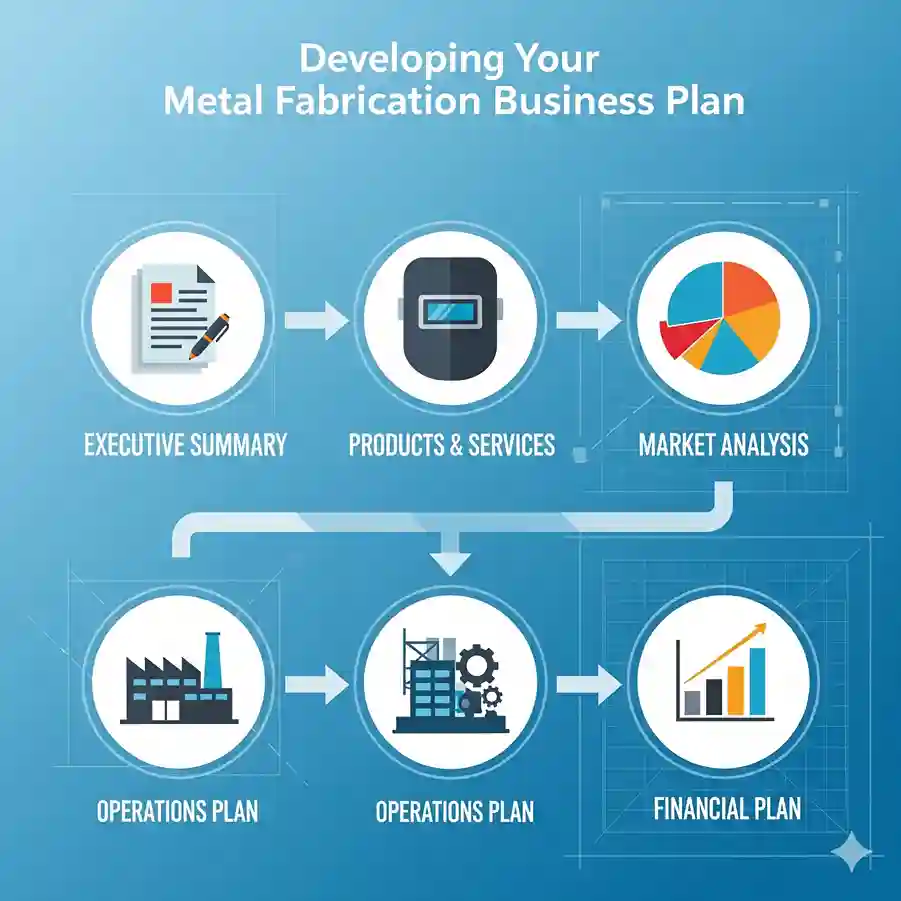Metal fabrication is a key component in the manufacturing landscape, supporting virtually all industries. Metal fabrication is the process of transforming raw metal into useful shapes and products. Metal fabrication is a complex business that requires precision, technical skills, and an eye for detail. It offers enormous potential to entrepreneurs who master its complexity.
Metal fabrication is more than just cutting and bending. It’s about solving issues, bringing ideas to life, and producing durable, essential products which drive economies forward. Understanding the nuances of metal fabrication is essential for an aspiring entrepreneur to create a successful path. This article is a comprehensive guide for developing a business plan that will help you succeed in a metal fabrication endeavor. It covers everything from market analyses and service offerings, to financial projections and safety and quality.

Understanding the Metal Fabrication Market
Metal fabrication is a diverse industry that serves a variety of industries, including
- Construction: Structural steel, railings, gates, custom architectural elements.
- Automotive Chassis, exhaust systems and specialized parts.
- Aerospace : Precision engineered parts for aircrafts and spacecraft.
- Energy: Infrastructure components for wind, solar, oil and gas.
- Manufacturing: Machine Frames, Enclosures, Conveyor Systems, Tooling.
- Consumer Goods: Appliances, furniture frames, decorative items.
- Agriculture: Farm equipment parts, specialized structures.
- Marine: Boat components, dock structures.
Global metal fabrication market is estimated at hundreds of billions dollars and will continue to grow. The growth of the metal fabrication market is driven by increased infrastructure development, manufacturing, and demand for specialized components in various industries.
Market Trends:
- Robotics and Automation: Adoption of automated cutting, welding, and bending to improve precision, efficiency, safety, and accuracy.
- Additive manufacturing (3D printing): Although not traditional fabrication it is impacting prototyping, specialized parts production and requires traditional finishers.
- High-precision components are in demand: The aerospace, medical and electronics industries have seen a rapid growth, driving the need for very tight tolerances.
- Sustainability : The focus is on reducing waste and energy consumption.
- Customization Growing demand for custom-made fabrication solutions instead of mass-produced items.
Read More: 15 High-Demand Manufacturing Startup Ideas for MSMEs and New Entrepreneurs
How to Develop a Metal Fabrication Business plan
Your roadmap to starting and growing a successful company in metal fabrication is a well-structured, detailed business plan.
1. Executive Summary
- Summary: An overview of your business, including mission, vision and products/services. Also includes competitive advantages, market target, financial projections, and competitive advantage. This should be a concise summary of your whole plan.
2. Company Name
- Business Name & Legal Structure: (e.g., [Your Company Name], Private Limited Company/Partnership/Sole Proprietorship).
- Mission Statement: (e.g. “To provide innovative metal fabrication solutions to customers that are superior in quality and service through innovation.
- Objectives and Goals: Specific, Measurable, Achievable, Relevant, Time-bound, and Relevant goals (e.g. “Achieve a 20% market share within 3 years in custom architectural fabrication,” “Maintain an overall customer satisfaction rate of 95 %”).
- Location: Outline your planned location and highlight its strategic advantages.
- Value Proposition What makes you unique as a business? (e.g. specialized welding capability, quick turnaround time, expertise in exotic materials, comprehensive design to finish service).
3. Products and Services
Define clearly what you’ll offer. Here you will identify your niche.
- Cutting:
- Shearing: for straight-line cuts
- Cutting: For larger profile.
- Plasma cutting: For thicker metals at good speed.
- Laser cutting: High precision and intricate designs.
- Waterjet cutting: for heat-sensitive materials and very thick pieces.
- Forming/Bending:
- Press Brakes: To bend sheets and plates.
- Rolling: To create cylindrical shapes.
- Stamping: To mass produce specific shapes.
- Welding:
- MIG (GMAW): Common for general fabrication.
- GTAW (TIG): High-quality, precision welds.
- Stick (SMAW): For heavy-duty outdoor work.
- Spot welding: for joining thin sheets
- CNC Milling and Turning: (If available) CNC milling or turning for precision part creation.
- Assembly: Combining parts into a final product.
- Finishing: Grinding and polishing, paint, powder coating, in-house or outsourcing.
- Design & Engineering support: (Value Added Service) CAD/CAM Services, prototyping.
Read More: Sustainable Lead Production: The Galena Plant Setup Process
4. Market Analysis
- Your target market: Who is your ideal customer? You can use small construction companies, furniture manufacturers, local machinery makers, or architectural practices as examples. Specificity is key.
- Market Size and Trends: Provide information on the growth of relevant industries in the target region (e.g. construction growth in North Dumdum or manufacturing expansion in West Bengal).
- Competitors: Identify both direct and indirect competition. Analyze the strengths and weaknesses of your competitors, their pricing, service offerings, and other factors. What will make you stand out?
- SWOT Analysis
- Strengths Internal Advantages (e.g. experienced team, specialized machinery, strong supplier networks).
- Weaknesses : Internal disadvantages e.g. limited capital, new brands, small teams.
- Opportunities Factors that you can take advantage of (e.g. new infrastructure projects, increasing demand for certain metal types, government incentives).
- Threats External Factors that can harm you (e.g. economic downturn, new competitors, rising material prices, skilled labor shortage).
5. Marketing and Sales Strategy
- Branding Create a strong brand image, including a logo, website and messaging that is consistent.
- Pricing Strategy: Cost-plus pricing, value-based pricing, competitive pricing.
- Sales Channels:
- Direct sales (sales team, networking).
- Online presence (professional website that showcases capabilities and portfolio).
- Trade shows and exhibitions in the industry.
- Local business directories, industrial associations and local trade organizations.
- Referral programs
- Digital marketing (SEO, B2B social media, content marketing to showcase projects, etc.)
- Customer relationship management (CRM) How do you plan to build and maintain long term relationships?

6. Operation Plan
- Production Process: Detailed workflow from raw materials intake to final product delivery.
- Equipment list: Specific equipment required (e.g. CNC laser cutters, press brakes, welding stations and grinding machines, overhead cranes). Compare new and used equipment, or lease versus buy.
- Source raw materials: Identify reputable suppliers for different metals (steel aluminum, stainless steel etc.). Other consumables such as welding wire, gases and grinding discs.
- Quality control: Procedures to inspect raw materials, check in-process, and ensure the quality of final products. A certification (e.g. ISO 9001), is a major advantage.
- Inventory Control: How do you plan to manage your raw materials, in-progress and finished goods?
- Safety Plan Essential in metal fabrication Detail safety protocols, including PPE requirements, maintenance schedules for equipment, and emergency procedures. It is important to comply with all local safety regulations.
7. Management Team
- Organizational structure: Simple chart showing key roles
- Key Personnel Experience and resumes of key employees and founders, with emphasis on relevant skills such as fabrication, engineering and sales.
- Advisory board: List external advisors if applicable.
Read Our Project Report: Steel and Steel Products, Iron and Steel…
8. Financial Plan
This section is usually the most important for securing funds.
- Startup costs: A detailed breakdown of the initial expenses (equipment/lease purchase/lease agreement, renovations to facilities, permits, inventory, marketing and working capital).
- Funding Requirement: For what purpose and how much capital are you looking for? What kind of funding do you seek (debt or equity)?
- Revenue Forecasts: Based on a realistic market analysis, 3-5-year forecasts are broken down by services.
- Operating Costs: Monthly/annual expenses (rent, utilities and salaries, raw materials for maintenance, insurance and marketing).
- Profit & Loss (P&L), Projection of income, costs and profit over time.
- Cash Flow statement: Displays the money that comes in and goes out. This is crucial for liquidity.
- Balance sheet: Snapshots for assets, liabilities and equity.
- Breakeven Analysis: What sales volume will cover your entire costs?
- Sensitivity analysis: How changes to key assumptions (e.g. material costs, sales volumes) impact your financials.
Read More: Manufacturing Business Opportunities in Steel and Steel Products
9. Appendix
- The resumes of key personnel: Resumes for the main folks on your team. This shows the people you’re working with and what they can do.
- Surveys and data from market research: Market research—yeah, think surveys, charts, the whole data dump. You need info about your market. This means asking people questions and looking at numbers.
- Customers can send letters of intent to purchase: Letters of intent from customers (basically, “I’m in if you build it” notes). If people want to buy from you, get it in writing.
- Equipment quotes: Quotes for any gear or equipment you need. Find out how much your stuff will cost.
- Permits and Licenses: Permits and licenses—yep, the fun paperwork. You need legal papers to run your business.
- Financial spreadsheets in detail: Detailed spreadsheets with all the financial nitty-gritty. Show exactly how much money you’ll make and spend.
Discover the Right Business for You With Our Startup Selector Tool
Conclusion
A metal fabrication business is more than a document to secure funding. It’s also a blueprint for success. You’ll be forced to analyze all aspects of your business plan, from the sparks in the workshop to your strategic choices that will guide your positioning on the market. In an industrial center like North Dumdum in West Bengal, there is a constant demand for precision metal parts, which makes it ripe for a successful fabrication business.
You can build a profitable and resilient business by carefully defining your vision, understanding the market, investing in safety and quality, and cultivating a culture of continual improvement. Metal fabrication can be a challenging journey, but with the right plan, dedication and unwavering commitment to quality, you can create a legacy of innovation that will contribute to your region’s manufacturing prowess.
Metal Fabrication Business Plan: Frequently Asked Questions
Q1. What licenses do you need to start a metal fabrication shop in North Dumdum?
You need MSME/Udyam registration, GST, PAN, and sometimes TAN. Get a trade license from the local municipality. If you have many workers, you’ll need a factory license. Pollution and fire clearances are a must. If you hire people, register for PF and ESI. Ask a local expert for the latest rules.
Q2. How much money do you need to start?
Starting a small shop will cost you between ₹25 and ₹60 lakh. You’ll spend the most on equipment like welders and cutters. You also need to pay for rent, licenses, some materials, and working money for salaries and bills. Second-hand machines can save cash but may need repairs.
Q3. How profitable is Metal Fabrication Business?
Profit depends on what you make. Basic items like gates have lower profits—5% to 10%. If you do special or custom work, you can earn more, up to 15%. Keep costs in check and do quality work to get repeat customers. Mistakes or waste can quickly eat your profit.
Q4. What are the biggest problems for a new fabrication shop (besides money)?
It’s tough to find good workers who know what they’re doing. Material prices go up and down a lot, so it’s hard to plan. And if your work isn’t perfect, people won’t trust you. You need good tools, careful checks, and skilled staff.
Q5. How to get your first clients?
Go and talk to local builders and contractors. Show them what you can do with photos or samples. Focus on one thing, like gates or stairs, so people remember you. Put your business online so people can find you easily. Ask happy clients for reviews.







